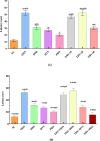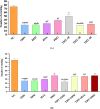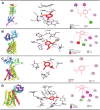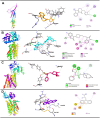Thymol as a Potential Natural Antiemetic: Insights From In Vivo and In Silico Studies
- PMID: 40937165
- PMCID: PMC12421314
- DOI: 10.1002/fsn3.70832
Thymol as a Potential Natural Antiemetic: Insights From In Vivo and In Silico Studies
Abstract
Nausea and vomiting are common and distressing responses to toxins, chemotherapy, and gastrointestinal disturbances. Although antiemetic medications are available, their adverse effects make safer substitutes necessary. In our study, Thymol (THY), a phenolic monoterpene from essential oils, was evaluated for its antiemetic potential using in vivo and in silico methods. In the in vivo study, emesis was induced in 2-day-old chicks by oral administration of copper sulfate pentahydrate (50 mg/kg). THY was administered orally at doses of 10, 20, and 40 mg/kg, alone or in combination with standard antiemetics ondansetron (ODN), domperidone (DPD), hyoscine butyl bromide (HYS), and promethazine hydrochloride (PRO). The 20 mg/kg dose (THY-20) showed the highest efficacy, significantly (p < 0.0001) reducing the number of retches (24.6 ± 2.7; 67.2% reduction) and increasing latency to first retch (52.6 ± 4.2 s; 77.18% increase) compared to the negative control (NC). The THY + ODN combination further enhanced effects (68.53% retch reduction). Molecular docking showed strong binding of THY to 5-HT3A (-6.4 kcal/mol), D2 (-7.1 kcal/mol), M3 (-6.2 kcal/mol), and H1 (-7.1 kcal/mol) receptors, comparable to standard drugs. Absorption, distribution, metabolism, excretion, and toxicity (ADMET) profiling revealed THY's compliance with Lipinski's Rule, high gastrointestinal absorption, blood-brain barrier permeability, and low toxicity risk. The multi-target binding profile and synergistic potential of THY suggest its promise as a natural, broad-spectrum antiemetic. Further receptor-specific studies and trials in chemotherapy-induced emesis models are recommended to validate its clinical potential.
Keywords: 5‐HT3 antagonist; GABAB agonist; calcium channel; nausea and vomiting; thymol.
© 2025 The Author(s). Food Science & Nutrition published by Wiley Periodicals LLC.
Conflict of interest statement
The authors declare no conflicts of interest.
Figures










References
-
- Ahmed, S. , Hasan M. M., and Ahmed S. W.. 2014. “Natural Antiemetics: An Overview.” Pakistan Journal of Pharmaceutical Sciences 27: 1583–1598. - PubMed
-
- Akbor, M. S. , Bappi M. H., Prottay A. A. S., et al. 2023. “Synergistic Hypnotic Effects of Sesamol and Thymol Possibly Through GABAergic Interaction Pathway: In Vivo and In Silico Studies.” Journal of Biological Regulators and Homeostatic Agents 37, no. 11: 6419–6435.
-
- Akita, Y. , Yang Y., Kawai T., et al. 1998. “New Assay Method for Surveying Anti‐Emetic Compounds From Natural Sources.”
-
- Al‐Malki, A. L. 2010. “Antioxidant Properties of Thymol and Butylated Hydroxytoluene in Carbon Tetrachloride‐Induced Mice Liver Injury.” Journal of King Abdulaziz University‐Science 22, no. 1: 239–248.
LinkOut - more resources
Full Text Sources

